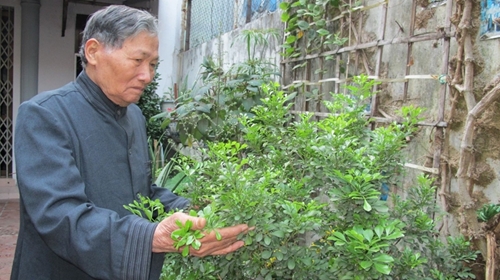That was the sharing of Vu Ngoc Bich from Hai Phong, who was a military physician in Dien Bien Phu campaign.
Green leeches - A terrible fear of female conscripted laborers
The most memorable thing that has remained in Bich’s mind was the early period of the campaign. He was in charge of two medical stations receiving wounded and sick soldiers of youth volunteers who were building roads, soldiers marching for the campaign, and frontline conscripted laborers at Lung Lo, Quang Huy and Hat Lot passes. Two stories left an everlasting impression on him.
    |
 |
|
Vu Ngoc Bich, a military physician in Dien Bien Phu campaign |
One day, the enemy discovered that the Vietnamese troops opened a new route. Immediately, they conducted air strikes and dropped bombs to destroy the road. Our units were confronted with a number of difficulties in transporting rice. Moreover, many troops had to share water. Therefore, female conscripted laborers and youth volunteers bought rice and several Chung cakes from H’mong ethnic people and shared them with us.
For the conscripted laborers, especially female ones, the scariest thing was leeches. Leeches often lived in the forest. Particularly in bamboo forests, there were a lot of green leeches. They were small and jumped quickly. As soon as someone appeared, they would surge forward, crawl into the slits of clothes, and suck their blood.
Giving first aid to wounded soldiers on the frontline
About a few kilometers from the frontline, there was a tunnel where military medical staff provided first aid for wounded soldiers and then quickly brought them to the rear for further treatment. As the deputy leader, I often handled the most dangerous cases.
A wounded soldier was taken with two wounds due to the enemy’s artillery shell fragments. One on the right side of the neck and one on the left thigh. Immediately, I treated the most dangerous wound on his neck. The bullet fragment sank deeply into the carotid artery. As soon as the bullet fragment was removed, blood spouted from the wound. Quickly, I pressed the wound to stop the bleeding and then bandaged the wound before taking the patient to the rear for further treatment.
In another case, three seriously wounded soldiers were transferred. One was injured and his belly was ripped up. The small and large intestines spilled out. I tried to put all of the large intestine into his stomach. For the small intestine, I sterilized a bowl and placed it over all the exposed intestines, then lapped a bandage around the bowl and brought him to the rear.
Of the two remaining soldiers, one suffered from traumatic brain injury, the other suffered 50% burns caused by napalm bombs. The three soldiers told me their names and asked me to write letters to their families. However, the tunnel later was bombed and I lost the letters. I just remembered that they came from Thai Binh, Thanh Hoa and Ha Dong, and the soldier from Ha Dong is Thai. In 1955, I joined a training course in Ha Dong. I met Thai’s family and heard the news that he had died. Until now, I still hope that if the two remaining soldiers are still alive, they can contact me via the People's Army Newspaper.
There were a lot of cases of soldiers and conscripted laborers suffering from protuberant abdomen and constipation during the campaign. After giving examinations, I found out that they did not have vegetables to eat for a long time. When marching or digging fortifications, they sweated heavily, but they did not have enough water to drink. Perhaps, all soldiers participating in Dien Bien Phu campaign craved vegetables.
According to Vu Ngoc Bich, a military medical officer in Dien Bien Phu Campaign
Translated by Quynh Oanh